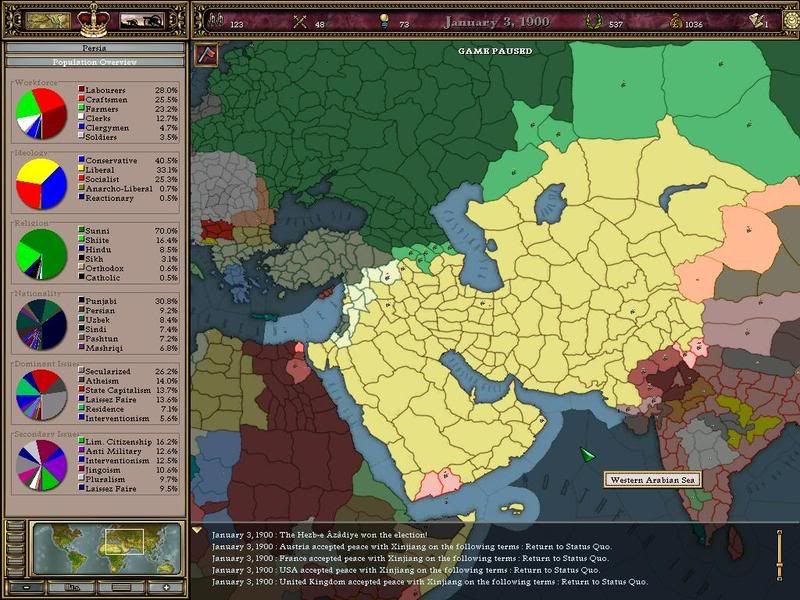Chapter 8: The Gathering Storm
Persia, having clawed and scratched and fought its way out of obscurity and poverty over the course of the decades before and after the Revolution, was now regarded as a Great Power. But even as she completed her grand ascension, the world began to shift perilously around her. The European great powers became ever more competitive as their interests began to collide more and more. The race for Africa, the unifications of Germany and Italy, the cries of nationalism from the subjugated peoples of the Austrian and Ottoman Empires, and the open and backroom deals, treaties, and alliances all signaled that the balance of power in Europe was beginning to shift. The competing interests of old and new, freedom and autocracy, and long-simmering rivalries and resentments would eventually set Europe, and perhaps the world, ablaze. It was simply a matter of time. There were but three non-European great powers whose involvements remained unknown quantities: the United States, Japan… and Persia.
It was during this period that Persia’s position as a great strategic asset was becoming more and more obvious: Already Kokand and Turkmenistan were known to be oil rich, with pumping operations already active in Dubai and the potential for further expansion in the future, all the great powers were eager to take advantage of Persia’s increasing wealth of critical oil. Luckily Persia was no longer a weak state capable of being easily manipulated or defeated militarily. And with the lines being drawn in Europe no one nation was capable of organizing a coalition great enough to overwhelm the Republic without meeting serious opposition, both from Persia and other jealous powers. Thus once more Persia’s security was ensured by the balance of power, but though such a tenuous status had served the Empire, and subsequently the Republic, as it emerged from obscurity, it could not be maintained. A side would need to be chosen. The Persian government remained abreast of developments abroad, however its main long-term strategic goal remained steadfast: the destruction of the Ottoman Empire. It was through this lens that the Republic’s policies would be crafted, and the means by which she would endure what was to come would be decided. As the Ottomans were allied to Germany, this entailed courting their rivals, chiefly Britain and Russia. Though both were traditionally friendly with the Republic, tensions with the Company and the Border War had soured relations with both. Thus a charm offensive was initiated in order to secure a strategic relationship within what would become the entente while for the moment remaining outside of it.
Secondly, remembering their embarrassing inability to cross the Bosporous and deliver the fatal blow to the Ottomans by taking Istanbul, as well as the need to secure the incredibly strategic waterways they controlled, a program was undertaken to expand and modernize what was still a barely existent navy. Luckily this was where the Republic’s excellent relationship with the United States began to pay off. Though still pursuing a policy of strategic Splendid Isolation, the two nations were on good enough terms that the Americans were willing to sell naval technology to the Republic. This relationship would also prove greatly beneficial as Persia served as a diplomatic conduit between America and Britain, and was instrumental in the Great Rapprochement between the two, which would later prove to be critical in convincing politicians in Washington to come to the aid of a former enemy. Further military strengthening on land was also required to keep pace with the armed forces of the other great powers, and thus not only were reserves increased but the standing army grown with the formation of the Army of Iraq in mid 1903. By late 1906, enough material and technological know how had been assembled to begin construction on Persia’s first modern warships: 4 protected cruisers, set for completion in 1909. They wouldn’t come soon enough.
On April 26th, 1907, the Sultan’s brother Reshad Efendi was dispatched to Pristina to meet Austrian officials to discuss strategic matters relating to the new Central Alliance. Serbian terrorism had by this point become a serious problem for both nations, and plans were being made regarding what to do about the problematic little polity that lay between them. What happened is still somewhat unclear, but what we do know is that as they exited the Austrian consulate a Serb anarchist approached the pair and their bodyguards, attempting to kill the Austrian ambassador. 1 bomb and 3 shots later, the ambassador had escaped, but his Ottoman counterpart lay dead. Enraged at the death of his brother, Sultan Abdul Hamid II immediately ordered his forces mobilized, and on the 28th declared war on Serbia. Russia, having bound itself to defending the slavs of central Europe, declared war on the Ottomans, forcing the activation of the full alliance and bringing responses in-kind from both Austria and Germany, which of course brought France, Britain, and Italy into war. Unwilling to allow the other great powers to divide up the Ottoman Empire, Persia finalized its entrance into the Entente, with the following conditions: in exchange for full and exclusive access both to the Suez Canal and it’s oil resources, the Republic would be granted the British East India Company’s remaining enclave in Aden as well as the rights to all remaining non-European Ottoman territory. And so, on May 6th 1907, the Persian Republic declared war on the Ottoman Empire and entered the conflict we now know as World War I.
-------------
Had to manipulate the situation here a bit to mirror the leadup to the great war, which historically was pretty much inevitable in some form. Can persia triumph and secure its place in the sun? Stay tuned to find out







